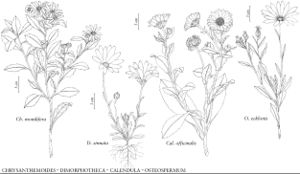Osteospermum
Sp. Pl. 2: 923. 1753.
Gen. Pl. ed. 5, 395. 1754.
| Taxon | Illustrator ⠉ | |
|---|---|---|
 | Chrysanthemoides monilifera Dimorphotheca sinuata Calendula officinalis Osteospermum ecklonis | Yevonn Wilson-Ramsey Yevonn Wilson-Ramsey Yevonn Wilson-Ramsey Yevonn Wilson-Ramsey |
Perennials, subshrubs, or shrubs [annuals], 5–150+ cm. Stems procumbent to erect [prostrate], glabrous or arachnose to piloso-hirtellous and/or stipitate-glandular. Leaves sessile or petiolate; blades orbiculate, elliptic, or oblong to oblanceolate, lanceolate, or linear, margins entire or denticulate [pinnately lobed], faces glabrous or sparsely arachnose and/or stipitate-glandular, often glabrate. Heads borne singly [in corymbiform to umbelliform arrays]. Involucres campanulate to hemispheric or broader, 5–20+ mm diam. Phyllaries 5–21+ in 1–2 (–3+) series, lanceolate to lance-linear (apices ± attenuate). Receptacles flat to conic. Ray-florets 10–21+ in ± 1 series; corollas whitish to purplish or yellow to orange, laminae ± oblongelliptic to oblanceolate. Disc-florets 12–50+, functionally staminate; corollas yellow or purplish, tubes shorter than the ± campanulate throats. Cypselae triquetrous-prismatic to clavate, often ± tuberculate or ridged and/or winged. x = 10.
Distribution
Introduced; Africa, widely cultivated, sometimes escaping and/or persisting
Discussion
Species ca. 75 (2 in the flora).
Selected References
None.
Lower Taxa
Key
| 1 | Leaf blades obovate or oblong to oblanceolate, 30–50(–100+) × 0–20(–40+) mm; ray corollas purplish to whitish | Osteospermum ecklonis |
| 1 | Leaf blades cuneate to clavate, 3–12(–20+) × 1–4+ mm; ray corollas yellow to orange. | Osteospermum spinescens |
"broader" is not a number.